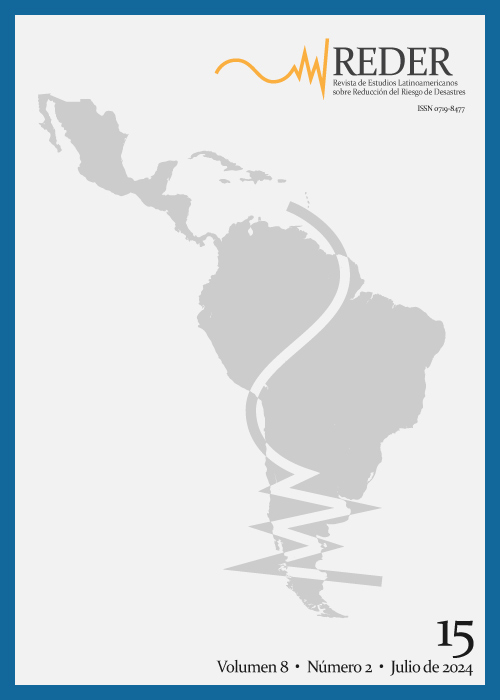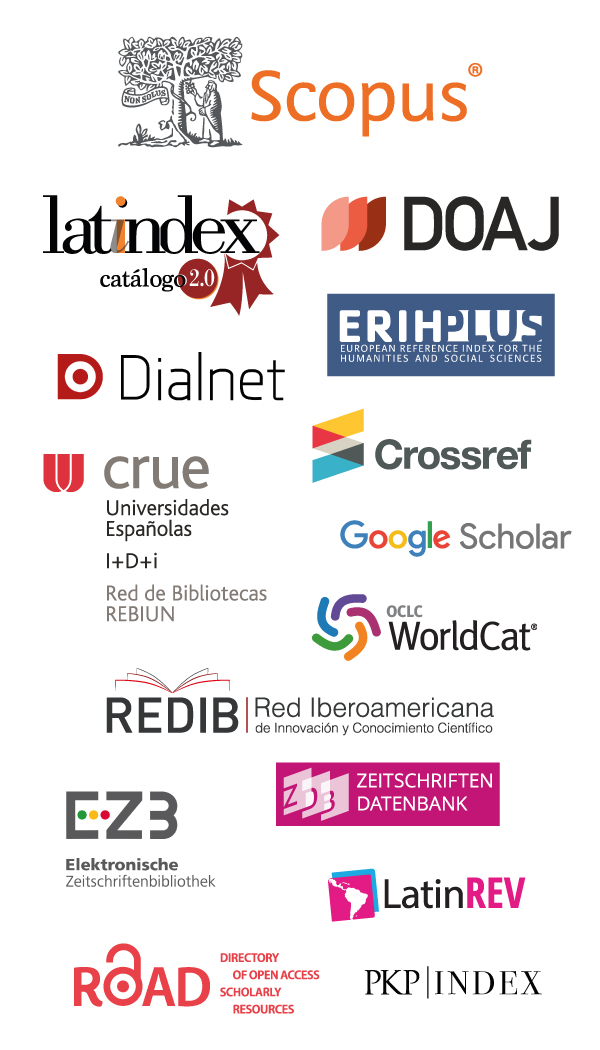Un Estudio de Caso Sobre el Uso del Suelo Urbano y los Riesgos de Desastres en Brasil
DOI: https://doi.org/10.55467/reder.v6i1.92
Resumen
En el contexto de una emergencia climática, las ciudades son territorios vulnerables propensos a varios riesgos de desastres de diferente naturaleza. Las ciudades latinoamericanas son especialmente vulnerables, con altas tasas de urbanización y graves problemas socioambientales. En este contexto, este trabajo aborda las estrategias para la reducción del riesgo de desastres (RRD) con énfasis en aquellos riesgos intensificados por los cambios climáticos, centrándose en el espacio urbano brasileño. Para observar estos vínculos, se llevó a cabo un estudio de caso: la cuenca hidrográfica ubicada en un área urbana de Brasil – Florianópolis. El artículo examina la interacción existente entre las políticas sectoriales para el uso del suelo urbano, el cambio climático y la RRD mediante el análisis de documentos internacionales y la legislación nacional y los marcos de políticas seleccionados en todas las áreas de gobernanza. Además, explora la disponibilidad y accesibilidad de datos oficiales en términos de eventos de desastres, riesgos climáticos, demografía de las poblaciones afectadas y áreas ambientalmente protegidas. Finalmente, arroja luz sobre el papel de la cartografía, en particular de los mapas de riesgo, en la coordinación de las reglas de uso del suelo y las políticas de RRD.
Palabras clave
Texto completo:
PDF (English)Referencias
Arnold, Craig Anthony. 1999. “Planning Milagros: Environmental Justice and Land Use Regulation”. Denver University Law Review, v. 76, no. 1.
Been, Vicki. 1993. “What’s Fairness Got to Do with It? Environmental Justice and the Siting of Locally Undesirable Land Uses”. Cornell Law Review, v. 78, no. 78: 1001–85.
Blomley, Nicholas, David Delaney, & Richard T. Ford (eds). 2001. Legal Geographies Reader: Law, Power and Space. Wiley-Blackwell Oxford.
Bullard, R. Doyle. 2000. Dumping in Dixie: Race, Class, and Environmental Quality. Colorado: Westview Press.
Eckstein, David, Marie-Lena Hutfils, & Maik Winges. 2018. Global Climate Risk Index 2019: who suffers most from extreme weather events? Weather-related loss events in 2017 and 1998 to 2017. Germanwatch e.V.
Fainstein, Susan S. 2010. The Just City. Cornell University Press.
Ferreira, Ximena Cardozo. 2017. Inundações urbanas: propostas para uma gestão do risco com foco na prevenção de danos. Dissertação de Mestrado. Universidade Vale do Itajaí.
Folly, Maiara. 2018. Migrantes Invisíveis: a crise de deslocamento forçado no Brasil. Artigo Estratégico, Instituto Igarapé.
Harvey, David. 2008. Social Justice and the City. University of Georgia Press.
Instituto Brasileiro de Geografia e Estatística IBGE. 2010. Censo Demográfico 2010. IBGE.
Instituto Brasileiro de Geografia e Estatística IBGE & Centro Nacional de Monitoramento e Alerta de Desastres. 2018. Populações em Áreas de Risco no Brasil. Técnico, Rio de Janeiro.
Instituto de planejamento urbano de Florianópolis IPUF. 2002. Levantamento aerofotogramétrico de 2002: cartas planialtimétricas. IPUF.
Intergovernmental Panel on Climate Change IPCC. 2014. Fifth Assessment Report (AR5). IPCC.http://www.ipcc.ch/report/ar5/
Lazarus, Richard J. 1993. Pursuing ‘Environmental Justice’: The Distributional Effects of Environmental Protection. Northwestern University.
Lefebvre, Henri. 1991. The Production of Space. Wiley-Blackwell.
Lyster, Rosemary. 2016. Climate Justice and Disaster Law. Cambridge University Press.
Maplecroft, Verisk. 2017. Climate Change Vulnerability Index. Verisk Maplecroft.
Marengo, Jose A, et al. 2016. Impacto, vulnerabilidade e adaptação das cidades costeiras brasileiras às mudanças climáticas: Relatório Especial do Painel Brasileiro de Mudanças Climáticas. Painel Brasileiro de Mudanças Climáticas.
Martinez-Alier, Joan. 2003. The Environmentalism of the Poor: A Study of Ecological Conflicts and Valuation. Edward Elgar Publishing.
Mitchell, Don. 2003. The Rigth to the City: Social Justice and the Fight for Public Space. Guilford Press.
Oficina de las Naciones Unidas para la Reducción del Riesgo de Desastres UNISDR. 2019. Memórias VI Plataforma Regional para la Redución del Riesgo de Desastres en las Américas. UNISDR.
Revi et. al. 2014. “Urban Áreas”. En Intergovernmental Panel on Climate Change (ed.), Climate Change 2014 – Impacts, Adaptation and Vulnerability: Regional Aspects”. Contribution of Working Group II to the Fifth Assessement Report of the Intergovernmental Panel on Climate Change. 535-612. IPCC.
Robinson, Cordula. 2016. How You Can Use Geographic Information Technology. Entrevista por Lauren Landry, Março, Northeastern’s Master of Professional Studies in Geographic Information Technology (GIT) Program, Northeastern University. https://www.northeastern.edu/graduate/blog/geographic-information-technology/
Robinson, Mary. 2018. Climate Justice: Hope, Resilience, and the Fight for a Sustainable Future. Bloomsbury Publishing.
Serviço Geológico do Brasil. 2013. Carta de Suscetibilidade a Movimentos Gravitacionais de Massa e Inundações: Município de Florianópolis. CPRM.
Schlosberg, David. 2009. Defining Environmental Justice: Theories, Movements, and Nature. Oxford University Press.
Taylor, Dorceta E. 2000. “The Rise of the Environmental Justice Paradigm: Injustice Framing and the Social Construction of Environmental Discourses”. American Behavioral Scientist, v. 43, no. 4: 508–80.
The World Bank. 2010. “Cities and Climate Change: an urgent agenda”. Open Knowledge Papers, Urban Development Series, no. 10. http://hdl.handle.net/10986/17381
Ugeda, Luiz. 2017. Direito Administrativo Geográfico. Fundamentos na Geografia e na Cartografia Oficial do Brasil.Geodireito.
United Nations UN. 2019. World Urbanization Prospects 2019. Population Division, United Nations.
United Nations UN. 2016. Report of the open-ended intergovernmental expert working group on indicators and terminology relating to disaster risk reduction. General Assembly Report, United Nations.
United Nations UN. 2015. Transforming our World: the 2030 Agenda for Sustainable Development Resolution adopted by the General Assembly on 25 September 2015. UN. http://www.un.org/ga/search/view_doc.asp?symbol=A/RES/70/1&Lang=E
United Nations Department of Economic and Social Affairs UNDESA. 2018. The World's Cities in 2018. Population Division, UNDESA.
United Nations Human Rights Council. 2019. Climate Change and Poverty - Report of the Special Rapporteur on Extreme Poverty and Human Rights (A/HRC/41/39). United Nations.
UN Habitat. 2019. Climate Change. UN-Habitat. https://unhabitat.org/topic/climate-change
UNEP. 2019. Environmental Rule of Law: First Global Report. UNEP.
Delmotte, V. et al. 2018. IPCC: Summary for Policymakers. In: Global Warming of 1.5°C. An IPCC Special Report on the impacts of global warming of 1.5°C above pre-industrial levels and related global greenhouse gas emission pathways, in the context of strengthening the global. World Meteorological Organization.
Walker, Gordon. P., & Harriet Bulkeley. 2006. “Geographies of Environmental Justice”. Geoforum, v. 37, no. 5: 655–59.
Enlaces refback
- No hay ningún enlace refback.








